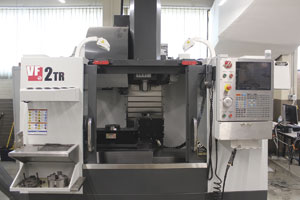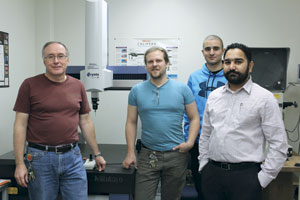Story and Images by Andrew Brooks
No hand-me-downs for George Brown College mechanical engineering students
Sometimes what you experience when you’re learning a skill can be as good as anything you’re likely to encounter in your career.
It’s a thought that some of the students at Toronto’s George Brown College (GBC) would endorse.
George Brown is widely reputed to be one of the best places in Canada to learn a skilled trade. And for a decade and a half, the college’s School of Mechanical Engineering Technologies students have learned their trade on state-of-the-art metrology and quality control equipment in two of the school’s ten labs. Almost all of the equipment has been supplied by Mitutoyo Canada.
“We have a quality control lab and a metrology lab,” says Parneet S. Saggu, professor/coordinator-CNC and Precision Machining. “The QC lab is pretty small, about 200 sq ft, and we take only small numbers of students there. All the precision equipment is kept there.”
The metrology lab is larger and has about 40 workstations with basic metrology equipment. Saggu calls this the “starter” lab, because this is where beginner students first learn to handle metrology equipment properly. Because the equipment gets rough treatment from students who’ve never handled it before, the college relies on simpler models of handheld metrology tools. More than half of them are also from Mitutoyo. In addition, there are two new Mitutoyo PH3500 profile projectors, acquired in 2015.
First-semester students from four programs use the metrology lab:
- Mechanical Technician – CNC & Precision Machining
- Electromechanical Engineering Technician
- Mechanical Engineering Technology – Design
- Electromechanical Engineering Technology – Building Automation
 Graduate and undergraduate students from university engineering programs also use the metrology lab. As Saggu explains, the university programs excel in educating on a theoretical level, but for hands-on, practical experience, they can’t do better than work with the equipment here. The course tailored for these students is called Mechanical Techniques.
Graduate and undergraduate students from university engineering programs also use the metrology lab. As Saggu explains, the university programs excel in educating on a theoretical level, but for hands-on, practical experience, they can’t do better than work with the equipment here. The course tailored for these students is called Mechanical Techniques.
George Brown students use the QC lab to inspect the parts they produce in CNC, Advanced CNC, Metrology and GD&T (geometric dimensioning and tolerancing) courses in the Mechanical Technician–CNC & Precision Machining and Mechanical Engineering Technology – Design programs.
The first semester starts with basic training in machining and measurement, using the basic micrometers, calipers and height gauges in the metrology lab, in addition to the two profile projectors. In the second semester, students begin to work on the college’s nine CNC machines and move up to digital tools. The SPC system is explored in the third semester, and in the fourth semester, students learn to operate the school’s CMMs.
 “When they’re in their final year, they produce a three-stage stamping, a progressive die,” Saggu says. “They make each and every part in our CNC labs. Once they’ve finished, they come into the QC lab and check the sizes and compare that with the original drawings. It’s a high level course and the work is quite complex.”
“When they’re in their final year, they produce a three-stage stamping, a progressive die,” Saggu says. “They make each and every part in our CNC labs. Once they’ve finished, they come into the QC lab and check the sizes and compare that with the original drawings. It’s a high level course and the work is quite complex.”
Quality control
The QC lab houses a Mitutoyo PH-3500 profile projector, a Mitutoyo Crysta 574 CMM (fitted with a Renishaw MH210 probe) and a FaroArm robotic probe arm. One of the more recent additions to the lab inventory is a mobile trolley-mounted Mitutoyo Statistical Process Control (SPC) system. The elements GBC has acquired:
- Absolute digital QM-Height gauge;
- IP65 Digimatic Micrometer;
- two Borematic bore gauges;
- IP67 Absolute vernier calipers;
- SJ-210 Surftest portable surface roughness tester;
- quick set test indicator set.
The SPC ensemble was acquired last summer. In addition to the tools, it is equipped with Mitutoyo’s MeasurLink statistical process control software with real-time data collection. The U-Wave measurement data wireless communication system enables data collected with the bore gauges, caliper, micrometer and QM-Height gauge to be automatically uploaded to a PC or into the cloud.
The lab also recently received a donated CMM (not Mitutoyo), which wasn’t yet operational when SMT visited. This second CMM has an unusual history, having last been used by a museum to scan paintings.
 Saggu points out that while the SPC system can be used in any setting, it’s especially useful in the aerospace industry, where tolerances and quality control standards are unforgiving.
Saggu points out that while the SPC system can be used in any setting, it’s especially useful in the aerospace industry, where tolerances and quality control standards are unforgiving.
“In the aerospace industry they have to keep a record of each individual part. With this system they don’t need to write that information on paper each time.” All data is automatically recorded and can be uploaded to the cloud or saved on a desktop PC.
“I’ve definitely noticed a difference between what we do and what other places do,” Saggu says. “I don’t know how many other colleges have the CMM machines that we do. Judging by the places I’ve been to, we’re probably one of very few colleges who have this kind of facility.”
The response of industry insiders to the college’s facilities and equipment has been positive. “We have a program advisory committee that consists of active industry partners–people who are running the industry. The last time they looked at our facility and the cutting edge technology that we have, they were amazed.”
The equipment infrastructure makes it very easy for students to transition into the industry, Saggu says. He doesn’t have the precise placement rate, but he and other instructors make it a priority to stay in touch with students after graduation, and he pegs the placement rate at 70 to 80 per cent.
But maybe there’s a sense in which the college’s cutting edge technology actually makes the transition to industry more difficult. Saggu tells the story of one graduate whose father runs a machine shop. “When he went back to work in his father’s business, he actually complained about how it took them such a long time to set up multiple tools. When he was here he got used to doing it in a few minutes.” SMT
